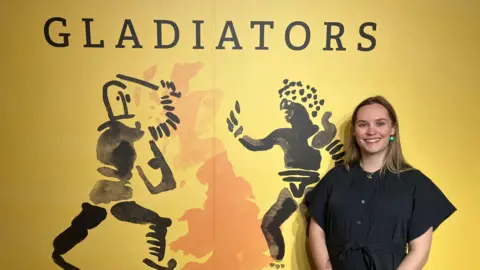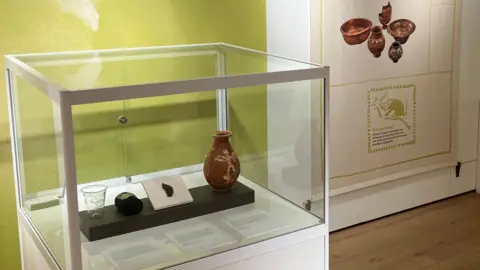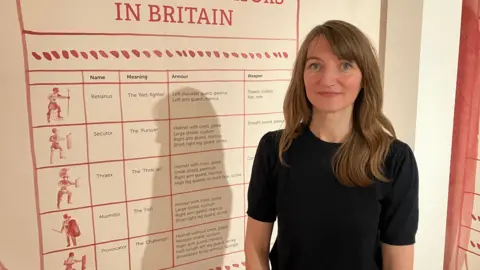Gladiators brought to life in new exhibition
 James Grant/BBC
James Grant/BBCA touring exhibition exploring the world of Roman gladiators has opened in Northamptonshire.
Northampton Museum & Art Gallery is hosting Gladiators of Britain, which offers insight into the gladiators who lived in the county and the wider country.
Local finds included two Nene Valley vessels depicting gladiators, fragments of an engraved glass from a Roman villa near Nether Heyford, and a clasp knife discovered in Piddington.
Jill Birrell, curator at Northampton Museum & Art Gallery, said: "[The items] show us the Romans who did live here engaged in spectacle culture... they made objects that have gladiators depicted on them and bought them, used them and lost them in the county."
 James Grant/BBC
James Grant/BBCGladiators are traditionally associated with arenas like the Colosseum in Rome, but many fights took place across Britain.
There was no amphitheatre in Northamptonshire, with the closest being at St Albans - formerly known as Verulamium.
There were 25 artefacts in the exhibition, including the Hawkedon Helmet - the only confirmed piece of gladiatorial armour from Roman Britain. It was possibly plundered from Colchester - known then as Camulodunum - during Boudica's rebellion of AD60.
According to the British Museum, the heavy bronze helmet originally had a tinned surface, and the wearer's face would have been encased in a hinged mask with eye guards.
 James Grant/BBC
James Grant/BBCAnother key exhibit is the Colchester Vase from AD175, discovered in a Roman-era grave in 1853.
Anna Willi, the curator for ancient Mediterranean life at the British Museum, added: "There are misconceptions about gladiatorial fights... we are trying to dispel some of these myths.
"For example, there were rules to the fights, there were umpires, and people didn't always fight to the death. In fact, a bout would last around 15 minutes because a dead gladiator was much more expensive than a wounded one that could fight more."
Gladiators of Britain is at Northampton Museum & Art Gallery until 7 September.
Follow Northamptonshire news on BBC Sounds, Facebook, Instagram and X.
